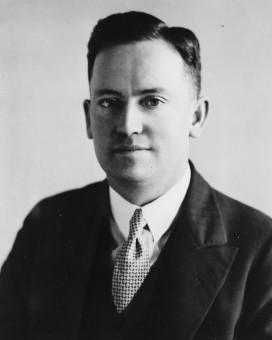On this page
1920 to 1929
17 Nov 1928: 1st elected to Federal Parliament
Curtin was elected as Member of Parliament for the seat of Fremantle (WA), in the 11th federal election.
1930 to 1939
19 Dec 1931: Lost seat
Curtin lost his seat of Fremantle in the 13th federal election, along with 32 other Labor members, in a landslide defeat.
15 Sep 1934: Regains seat
Curtin was re-elected as Member of Parliament for Fremantle in the 14th federal election.
1 Oct 1935: Labor leader
Curtin was elected as leader of the Labor party after the resignation of James Scullin.
1940 to 1949
7 Oct 1941: 14th Prime Minister
Curtin was sworn in as prime minister after the Fadden coalition government lost majority support in the House of Representatives.
19 Nov 1941: HMAS Sydney (II)
The HMAS Sydney and the German raider Kormoran fought an hour-long battle 150 miles (241km) west of Shark Bay, Western Australia. Both vessels were stricken. Sydney was on fire but moved slowly away. Most of Kormoran's crew survived and were picked up, but Sydney and all 645 men aboard disappeared. 10 anguished days later, Curtin made the news public.
9 Dec 1941: Declaration of war
2 days after the Japanese attack on the United States naval base at Pearl Harbor, Australia declared war on Japan, and on Axis powers, Finland, Hungary and Romania.
19 Feb 1942: Bombing of Darwin
Japanese bombers made the 1st attack on Darwin 4 days after Japan captured Singapore. The Japanese advance was stopped in the battles of the Coral Sea and Midway atoll in May, and at Kokoda in November 1942. Attacks on Darwin and Katherine continued until November 1943. Bombs were also dropped on Townsville, Queensland, and Wyndham, Derby, Broome and Port Hedland in Western Australia.
31 May 1942: Submarines in Sydney Harbour
A torpedo fired from a midget submarine missed its target, the USS Chicago, and struck HMAS Kuttabul at Garden Island in Sydney Harbour, killing 19 sailors. 2 other midget submarines, launched from a flotilla of Japanese submarines lying off the coast, were disabled and captured.
7 Jun 1942: Income tax goes federal
Enactment of the Income Tax (War-time Arrangements) Act enabled the Commonwealth to take over from the states the power to levy personal income tax.
11 Aug 1942: Hollywood bombshell
Film star and Austrian refugee, Hedy Lamarr, and a fellow inventor took out a United States patent for a technique for generating a secure spectrum of radio frequencies to guide torpedoes. The technique was later used in missiles and for mobile phones.
24 Dec 1942: Planning for a future
A Department of Post-War Reconstruction was established. Dr Herbert Cole Coombs was appointed Director-General in January 1943.
3 Mar 1943: Soviet embassy
A Soviet embassy was established in Canberra, and an Australian diplomat was posted to Moscow.
14 May 1943: Centaur tragedy
The hospital ship Centaur with 268 people aboard was torpedoed off Cape Moreton, Queensland. It sank in 3 minutes, with all lives lost. It was en route to the war zone and carrying no patients.
21 Aug 1943: 17th federal election
Curtin led Labor to a significant victory, retaining government and significantly increasing their majority in both Houses.
23 Sep 1943: 1st women in Federal Parliament
40 years after women candidates 1st stood for parliament, Dame Enid Lyons and Dorothy Tangney became the 1st women to win seats. Enid Lyons took a seat in the House of Representatives and Dorothy Tangney a seat in the Senate.
22 Jul 1944: World Bank
The agreement by Allied powers to establish the World Bank and the International Monetary Fund was reached at Bretton Woods, New Hampshire. The initial aim was to establish international institutions to fund reconstruction in countries ravaged by the Second World War.
5 Aug 1944: Cowra outbreak
Japanese prisoners of war broke out of their detention camp in Cowra, New South Wales. They were armed with improvised weapons and 231 prisoners were killed and 108 wounded. The survivors were captured in the next few days.
19 Aug 1944: Referendum
A proposal related to post-war reconstruction and democratic rights, including constitutional guarantees of freedom of speech and religion, was not carried.
14 Dec 1944: Liberal Party of Australia
The new party was formed at a conference in Canberra. It emerged from an agreement to merge the United Australia Party and other non-Labor organisations, including the extensive Australian League of Women Voters.
30 Jan 1945: 11th Governor-General
The Duke of Gloucester served as governor-general until 11 March 1947. Sir Winston Dugan was acting governor-general from 19 January to 11 March 1947.
25 Apr 1945: United Nations
The San Francisco conference to establish the United Nations opened. A new organisation to promote international peace, replacing the League of Nations, had been planned since representatives from China, the United Kingdom, the Soviet Union and the United States met at Dunbarton Oaks in Washington DC in 1944. 46 nations sent delegates to draw up the Charter, which was signed on 26 June 1945.
8 May 1945: VE-Day
Germany's surrender to the Allied forces ended the war in Europe.
5 July 1945: Death
Curtin died at The Lodge, aged 60. He was the 2nd Australian prime minister to die in office within 6 years





